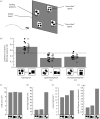Non-numerical strategies used by bees to solve numerical cognition tasks
- PMID: 33593192
- PMCID: PMC7934903
- DOI: 10.1098/rspb.2020.2711
Non-numerical strategies used by bees to solve numerical cognition tasks
Abstract
We examined how bees solve a visual discrimination task with stimuli commonly used in numerical cognition studies. Bees performed well on the task, but additional tests showed that they had learned continuous (non-numerical) cues. A network model using biologically plausible visual feature filtering and a simple associative rule was capable of learning the task using only continuous cues inherent in the training stimuli, with no numerical processing. This model was also able to reproduce behaviours that have been considered in other studies indicative of numerical cognition. Our results support the idea that a sense of magnitude may be more primitive and basic than a sense of number. Our findings highlight how problematic inadvertent continuous cues can be for studies of numerical cognition. This remains a deep issue within the field that requires increased vigilance and cleverness from the experimenter. We suggest ways of better assessing numerical cognition in non-speaking animals, including assessing the use of all alternative cues in one test, using cross-modal cues, analysing behavioural responses to detect underlying strategies, and finding the neural substrate.
Keywords: accumulator model; animal cognition; inhibition of return; magnitude; spatial frequency.
Figures



Similar articles
-
The mysterious cognitive abilities of bees: why models of visual processing need to consider experience and individual differences in animal performance.J Exp Biol. 2012 Feb 1;215(Pt 3):387-95. doi: 10.1242/jeb.038190. J Exp Biol. 2012. PMID: 22246247 Review.
-
High-Speed Videography Reveals How Honeybees Can Turn a Spatial Concept Learning Task Into a Simple Discrimination Task by Stereotyped Flight Movements and Sequential Inspection of Pattern Elements.Front Psychol. 2018 Aug 3;9:1347. doi: 10.3389/fpsyg.2018.01347. eCollection 2018. Front Psychol. 2018. PMID: 30123157 Free PMC article.
-
Seeing near and seeing far; behavioural evidence for dual mechanisms of pattern vision in the honeybee (Apis mellifera).J Exp Biol. 2012 Feb 1;215(Pt 3):397-404. doi: 10.1242/jeb.060954. J Exp Biol. 2012. PMID: 22246248
-
Individual personality differences in goats predict their performance in visual learning and non-associative cognitive tasks.Behav Processes. 2017 Jan;134:43-53. doi: 10.1016/j.beproc.2016.08.001. Epub 2016 Aug 8. Behav Processes. 2017. PMID: 27514774 Review.
-
Tiger salamanders' (Ambystoma tigrinum) response learning and usage of visual cues.Anim Cogn. 2016 May;19(3):533-41. doi: 10.1007/s10071-016-0954-9. Epub 2016 Jan 21. Anim Cogn. 2016. PMID: 26796198
Cited by
-
Disparate processing of numerosity and associated continuous magnitudes in rats.Sci Adv. 2024 Feb 23;10(8):eadj2566. doi: 10.1126/sciadv.adj2566. Epub 2024 Feb 21. Sci Adv. 2024. PMID: 38381814 Free PMC article.
-
Illusional Perspective across Humans and Bees.Vision (Basel). 2022 May 31;6(2):28. doi: 10.3390/vision6020028. Vision (Basel). 2022. PMID: 35737416 Free PMC article. Review.
-
Numerical discrimination in Drosophila melanogaster.Cell Rep. 2023 Jul 25;42(7):112772. doi: 10.1016/j.celrep.2023.112772. Epub 2023 Jul 14. Cell Rep. 2023. PMID: 37453418 Free PMC article.
-
Through an animal's eye: the implications of diverse sensory systems in scientific experimentation.Proc Biol Sci. 2024 Aug;291(2027):20240022. doi: 10.1098/rspb.2024.0022. Epub 2024 Jul 17. Proc Biol Sci. 2024. PMID: 39016597 Free PMC article. Review.
-
Archerfish number discrimination.Elife. 2022 Jan 10;11:e74057. doi: 10.7554/eLife.74057. Elife. 2022. PMID: 35001869 Free PMC article.
References
-
- Guiraud M, Roper M, Chittka L. 2018High-speed videography reveals how honeybees can turn a spatial concept learning task into a simple discrimination task by stereotyped flight movements and sequential inspection of pattern elements. Front. Psychol. 9, 1347. (10.3389/fpsyg.2018.01347) - DOI - PMC - PubMed
Publication types
MeSH terms
Associated data
LinkOut - more resources
Full Text Sources
Other Literature Sources

